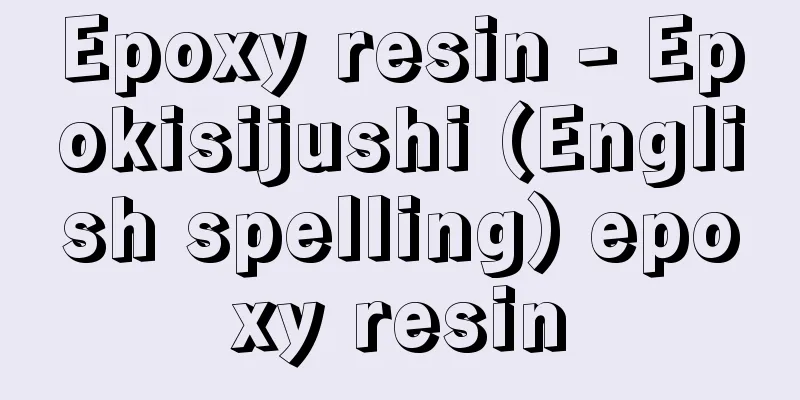Epoxy resin - Epokisijushi (English spelling) epoxy resin

|
A general term for synthetic resins with relatively low molecular weights that have two or more epoxy groups in one molecule and can harden in three dimensions in the presence of a hardener or catalyst. Its history is relatively recent, having been introduced after World War II as a strong adhesive for metals. When bisphenol A and epichlorohydrin, the raw materials for epoxy resins, are reacted in the presence of caustic soda, a primary resin (prepolymer) with a molecular weight of about 340 to 4000 is obtained, depending on the molar ratio of the mixture. This ranges from a low molecular weight, viscous oil to a high molecular weight, brittle, pale yellow solid. When a calculated amount of diamine (secondary amine), triamine (tertiary amine), imidazole, or acid anhydride such as phthalic anhydride is added to this primary resin, for example, in aliphatic amines, the epoxy groups are opened at room temperature or when heated, and the resulting hydroxyl groups react to form crosslinks. Depending on the type of hardener and, if necessary, inorganic filler, different properties of the hardened product can be obtained. Another type of epoxy resin is cresol novolac epoxy resin, which is made by reacting o-cresol novolac resin, obtained by reacting o-cresol with formaldehyde under acidic conditions, with epichlorohydrin in the presence of sodium hydroxide. This is crushed, mixed with silica (silicon dioxide), and hardened with acid anhydrides to create a system that is widely used as an encapsulant for electronic materials (a material that protects against moisture, dust, impact, etc.). Epoxy resins have excellent affinity with metal surfaces, so they are used especially as metal adhesives and paints. They produce little volatile substances or shrink in volume when cured, have excellent mechanical properties and electrical insulation, and are not affected by solvents. The maximum usable temperature of the cured product is determined by the type of epoxy resin and the combination of various hardeners, and can be as high as 300°C. There are a variety of processing methods, including casting, encapsulation, curing after impregnation, painting, and adhesion. Due to its good affinity with metals, its applications are diverse, including paints, metal adhesives, copper-clad laminates for electronic devices made by impregnating glass or carbon fibers with an epoxy resin prepolymer solution and then hardening them, aviation equipment made from carbon fibers, golf club shafts and fishing rods, road paving, and polyvinyl chloride resin stabilizers. [Hiroshi Kakiuchi] "Lectures on Plastic Materials: Epoxy Resins" edited by Hashimoto Kuniyuki (1982, Nikkan Kogyo Shimbun)" ▽ "New Epoxy Resins" by Kakiuchi Hiroshi (1985, Shokodo)" ▽ "Epoxy Resin Handbook" edited by Shinbo Masaki (1987, Nikkan Kogyo Shimbun)" ▽ "Introduction to Epoxy Resins" by Muroi Soichi and Ishimura Shuichi (1988, Polymer Publishing Association)" ▽ "Recent Advances in Epoxy Resins" edited by Kakiuchi Hiroshi (1990, Shokodo)" ▽ "High Performance Epoxy Resins and Market Outlook" edited and published by CMC (1990)" ▽ "New Developments in Epoxy Resin Hardeners" by Kakiuchi Hiroshi (1994, CMC)" ▽ "Easy-to-understand Epoxy Resins" by Muroi Soichi (1994, Kobunsha)" ▽ "Market Analysis and Future Outlook for Epoxy Resins" edited and published by CMC (1994)" ▽ "Environmental hormones and chemical substances of concern for the environment - the current situation and the response of the industry" (1999) edited and published by CMC" "Polymer additives market ('99)" (1999) edited and published by CMC " "Epoxy Resin Technology Association, General overview of epoxy resins, 4 volumes" (2003) [References] | | | | |crosslinking| | | | | | | |Source: Shogakukan Encyclopedia Nipponica About Encyclopedia Nipponica Information | Legend |
|
1分子中に2個以上のエポキシ基をもち、硬化剤または触媒の存在で三次元硬化ができる比較的分子量の小さい合成樹脂の総称。歴史は比較的新しく第二次世界大戦後、金属の強力な接着剤として紹介された。エポキシ樹脂などの原料であるビスフェノールAとエピクロロヒドリン(エピクロルヒドリン)とをカ性ソーダ(水酸化ナトリウム)の存在で反応させると、その配合モル比によって異なるが、分子量340~4000程度の第一次樹脂(プレポリマー)が得られる。これには低分子量の粘りのある油状のものから、分子量の大きなもろい淡黄色の固体のものまである。この第一次樹脂は、ジアミン(第二アミン)、トリアミン(第三アミン)やイミダゾール類、または無水フタル酸のような酸無水物を計算量添加すると、たとえば脂肪族アミンでは常温で、または加温するとエポキシ基の開環、それによって生じたヒドロキシ基との反応がおこり架橋結合を生成する。硬化剤や必要に応じて添加する無機質の充填(じゅうてん)剤(フィラー)の種類によって性質の異なった硬化物が得られる。 いま一つのタイプのエポキシ樹脂としては、o(オルト)-クレゾールとホルムアルデヒドとを酸性で反応させて得られた、o-クレゾールノボラック樹脂とエピクロルヒドリンとを水酸化ナトリウムの存在で反応させたクレゾールノボラックエポキシ樹脂がある。これを粉砕してシリカ(二酸化ケイ素)と混ぜ、酸無水物類とで硬化させるシステムで電子材料の封止材(湿気、ほこり、衝撃などから保護する材料)として広く使用されている。 エポキシ樹脂は金属表面との親和性が優れているので、とくに金属の接着剤や塗料として用いられる。硬化の際に揮発性物質の発生や体積収縮が少なく、機械的性質や電気絶縁性が優れ、溶剤に侵されない。硬化物の最高使用温度は、エポキシ樹脂の種類と、各種の硬化剤の組合せで決まり、高いものは300℃くらいまでのものがある。加工方法は注型、封入、含浸後硬化、塗装、接着など多様にわたっている。 用途は、金属との親和性のよいことから、塗料、金属接着剤に、あるいはガラス繊維や炭素繊維にエポキシ樹脂プレポリマー溶液を含浸させたあと、硬化させた電子機器用銅張り積層板、炭素繊維を用いた航空器材、ゴルフクラブのシャフトや釣り竿(ざお)などから、道路舗装、塩化ビニル樹脂の安定剤など多方面にわたっている。 [垣内 弘] 『橋本邦之編著『プラスチック材料講座 エポキシ樹脂』(1982・日刊工業新聞社)』▽『垣内弘著『新エポキシ樹脂』(1985・昭晃堂)』▽『新保正樹編『エポキシ樹脂ハンドブック』(1987・日刊工業新聞社)』▽『室井宗一・石村秀一著『入門エポキシ樹脂』(1988・高分子刊行会)』▽『垣内弘編著『エポキシ樹脂最近の進歩』(1990・昭晃堂)』▽『シーエムシー編・刊『エポキシ樹脂の高機能化と市場展望』(1990)』▽『垣内弘著『エポキシ樹脂硬化剤の新展開』(1994・シーエムシー)』▽『室井宗一著『わかりやすいエポキシ樹脂』(1994・工文社)』▽『シーエムシー編・刊『エポキシ樹脂の市場分析と将来展望』(1994)』▽『シーエムシー編・刊『環境ホルモン・環境汚染懸念化学物質――現状と産業界の対応』(1999)』▽『シーエムシー編・刊『高分子添加剤市場('99)』(1999)』▽『エポキシ樹脂技術協会編・刊『総説エポキシ樹脂』全4巻(2003)』 [参照項目] | | | | | | | | | | | | |出典 小学館 日本大百科全書(ニッポニカ)日本大百科全書(ニッポニカ)について 情報 | 凡例 |
>>: Epoxidation - Epokisika (English spelling)
Recommend
Soranus of Ephesus
A Greek physician active in Alexandria and Rome in...
Pauson, PL
...Many new types of organometallic compounds wer...
Slocum, J.
…They were probably more free than the upper clas...
Arachniodes hekiana (English spelling) Arachniodeshekiana
…[Shigeyuki Mitsuda]. … *Some of the terminology ...
Shoshikai - Shoshikai
[1] 〘 noun 〙① A banquet held to honor the elderly ...
fufu
…Tapioca flakes, made by slicing the tubers and d...
Jelenia Góra
Located in southwest Poland, 100 km west-southwest...
Casio Computer Co., Ltd.
An electronics manufacturer that deals in electron...
Jodo-e
This is a ceremony held to commemorate the Buddha&...
Silver tsuba - Gintsuba
1. A sword guard made of silver. Also, a sword gua...
Cylinder seal
…A seal made of small cylindrical stone with a pa...
Stump puller
A machine that uses a rope or chain to pull up roo...
Kumiya
One of the early wealthy merchants active in the e...
Shrimp Bug - Shrimp Bug
An insect belonging to the order Hemiptera and th...
Liar - Liar
...In modern society, telling lies or exaggeratio...









